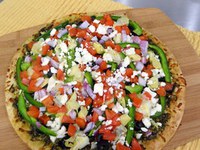Prairie Fare: Is Anyone Else Anxious for Spring?
(Click an image below to view a high-resolution image that can be downloaded)
By Julie Garden-Robinson, Food and Nutrition Specialist
NDSU Extension
The woman looked in my cart, glanced up at me and smiled.
“I know how you feel,” she said.
I didn’t look sad or dejected, by the way. I laughed and kept adding more items to my cart.
What was I loading in my cart? I’ll give you a hint: I was in a hardware and home goods store.
I didn’t have my cart filled with candy, chips and soda, which you might find in that type of retail store.
I was picking out packets of flower and vegetable seeds, and seed-starting media. I want to grow things.
What would you expect from someone who has “Garden” as part of her name?
In the Midwest and across much of the U.S., we have had a long, cold, snowy winter. I think we are ready for some grass spears and leaves to begin appearing.
Although we can’t begin planting outdoors, at least in North Dakota, we can start seeds indoors.
Our Field to Fork website at https://www.ag.ndsu.edu/fieldtofork/archived-webinars has a new recorded webinar, “Successful Seed Starting at Home” to view. It covers all the basics, including any auxiliary lights that might help promote your success.
If you are not thinking about growing vegetables or flowers to plant outdoors, maybe a houseplant would provide some greenery in contrast with our white-coated outdoor world. Check out the new “Trendy and Healthy Houseplants” webinar on the Field to Fork website for more information.
You’ll note that house plants do more than beautify your indoor environment. They help purify your indoor air. In fact, according to scientists at NASA, Pennsylvania State University and the University of Georgia, house plants can absorb volatile organic compounds, including benzene and formaldehyde from plastics, detergents and other chemicals.
You also can enhance your plate with colorful plant material at any time of the year. Fruits and vegetables are available in canned, dried, frozen and fresh forms, and they all count toward the recommended daily amount (at least 4 1/2 total cups daily).
March is designated as National Nutrition Month by the Academy of Nutrition and Dietetics. This is a good time to think about what we put on our plate and perhaps growing some of the food.
I have some “food for thought” for you in the form of a few questions:
- Yes or No: Do you include a variety of healthful foods from all of the food groups (fruits, vegetables, grain, protein, dairy) in your meals on a regular basis?
- Yes or No: Do you meet the recommendation for fruits and vegetables (at least 4 1/2 cups daily)?
- Yes or No: Do you select more healthful options when eating away from home?
- Yes or No: Are you mindful of portion sizes?
- Yes or No: Do you help reduce food waste by considering the foods you have on hand before buying more at the store?
- Yes or No: Do you make food safety part of your everyday routine?
NDSU Extension has a wide range information on all of these topics from gardening to nutrition. Visit https://www.ag.ndsu.edu/food to learn more. Also check out the face-to-face nutrition and/or food safety classes available from Extension in your community or area.
Nutrition plays a major role in your long-term health, and so does physical activity. Be sure to aim for at least 30 minutes of moderate physical activity on most days of the week. Yes, snow shoveling counts toward the goal, but so do lawn mowing and gardening.
Here’s a colorful pizza recipe. Pesto often is available in the refrigerator section of your grocery store or you can make it at home in a food processor from basil leaves, garlic, olive oil, Parmesan cheese and pine nuts or walnuts.
Soon we will be able to grow a lot of the toppings for this recipe. That’s my plan, anyway.
Pesto Pizza
1 (12-inch) pre-baked thin-crust pizza crust
4 ounces pesto
1 ripe tomato, chopped
1/2 c. green bell pepper, chopped
2 ounces chopped black olives, drained (optional)
1/2 small red onion, chopped
1 (4-ounce) can artichoke hearts, drained and sliced
1 c. crumbled feta cheese
Preheat oven to 450 F. Spread pesto on pizza crust. Top with tomato, bell pepper, olives (if desired), red onion, artichoke hearts and feta cheese. Bake for eight to 10 minutes, or until cheese is melted and browned.
Makes six servings. Each serving has 300 calories, 15 grams (g) fat, 10 g protein, 6 g carbohydrate, 2 g fiber and 800 milligrams sodium.
(Julie Garden-Robinson, Ph.D., R.D., L.R.D., is a North Dakota State University Extension food and nutrition specialist and professor in the Department of Health, Nutrition and Exercise Sciences. Follow her on Twitter @jgardenrobinson)
NDSU Agriculture Communication - March 7, 2019
| Source: | Julie Garden-Robinson, 701-231-7187, julie.garden-robinson@ndsu.edu |
|---|---|
| Editor: | Ellen Crawford, 701-231-5391, ellen.crawford@ndsu.edu |



